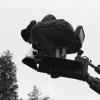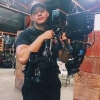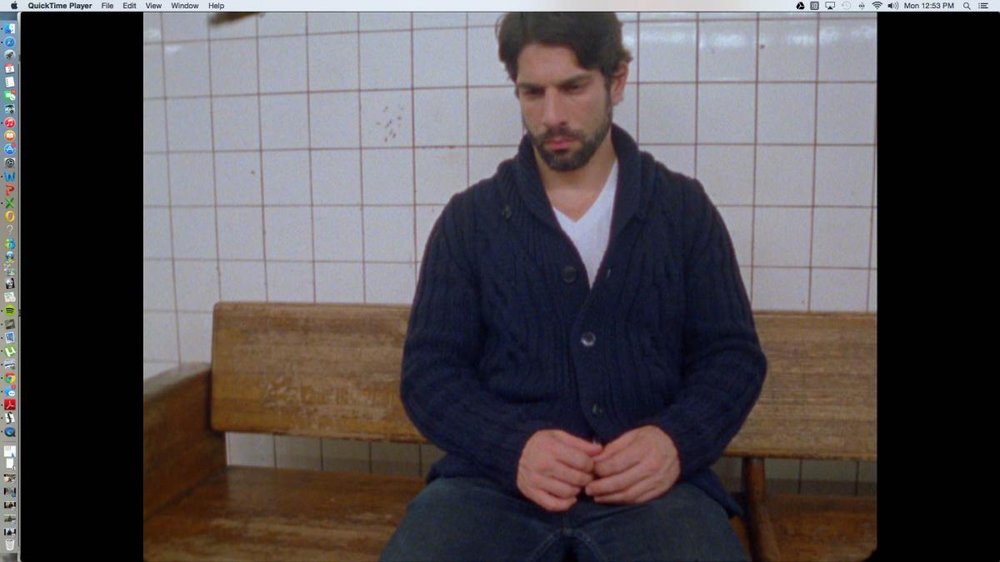Search the Community
Showing results for tags '7219'.
-
Hello everyone, I am currently shooting a feature on both S16 and S35mm stock. When shooting on S35 (5207) my blacks are black and look really nice, I keep them around 4-5 stops under and they look great. But when it comes to 7207/7219 if I do the same they look super grainy a bit too much. How can I reduce the grain in the shadows? 1. Is it better if I rate my 7207 at 200ASA or even 160ASA? 2. Should I rate my 7207 at 125ASA and then pull down one stop? 3. Should I try and keep the darkest part on the frame 3.5 / 4 stops under and try and maintain that with my spot meter instead of letting it go lower and then later crush it in post to get rich blacks? A bit lost here on what would be the best approach for this. Thanks
-
Hey everyone, I'm getting ready for a film challenge where our entire short will be made on a single 100 ft reel of Kodak 7219 and shot on a Krasnogorsk-3. In preparation for the shoot I decided to do a lens test with the stock Meteor 5-1 lens on my original Blackmagic Pocket Camera. Surprisingly though, my footage all seemed to be about a stop under exposed. I know that the aperture of a lens doesn't always let in as much light as it should and that T-stops are supposed to correct for this, right? So is this the case here? Have those of you that use the Krasnogorsk-3 encountered this problem? Does this mean that when shooting I should meter for 250 instead 500 to get proper exposure? Any thoughts?
- 4 replies
-
- krasnogorsk3
- meteor 5-1
-
(and 7 more)
Tagged with:
-
Finished another camera test with my Canon Scoopic 16 (Original Model) this time I pushed 7219 +1 stop instead of +2 and shot during sunset instead of the dead of night. I rated the film stock at 800 and metered normally. Processed at the Kodak Lab in NYC - Tony was such a great help and his communication was instant anytime I reached out to him. Scanned at Metropolis Post on their Director at 2K Flat Pass ProRes 444HQ - The team at Metpost was also great to deal with and had instant communication with me and never made me wait. Turn around time was faster than expected. Color Graded with Davinci Resolve Extremely happy with both Kodak and Metropolis post definitely will be sending more work to them. Camera Serviced by Bernie at Super16Inc
- 7 replies
-
- 2
-

-
- Canon Scoopic 16
- Kodak 500T
- (and 3 more)
-
Dear Cinematographers, Been carrying around two 100 ft. rolls of 16mm 500T film for the last year. It has been in a 10˚-20˚ cooler for six months. Someone told me freezing negative film would cause the remjet to stick, so I then refrigerated it in about 40˚ for six months. Now that I am ready to shoot it, the question presents itself: How am I to expose it in order to compensate for the yearlong stagnation? That is, if it not already too late. Sincerely Grateful, Kurt Cassidy-Gabhart
-
Hi, first time posting here. Has anyone tried to shoot 2x anamorphic lenses with 16mm film (let's say kodak 7219 stock) and how did it go? From what I knew, 16mm has 1.37:1 ratio. So use with 2x anamorphic lenses it's gonna be 2.74:1 which wider than 2.40:1. So I have more room to readjust a frame in post right? What about the image quality, does it look good? I did a research online but I haven't seen any decent one yet. FYI: I'm planing to shoot on Arri SR-II, Kodak 7219 and Kowa Prominar anamorphic prime set. Thanks in advance.
-
As it looks like I will be getting either a 2K or 4K scan for my 16mm short film (and not doing a traditional A/B negative cut,) my main concern now is preserving the grain structure that I achieved in-camera. I went for a specific look with this film and pushed 7219 2 stops, creating a nice amount of grain. As I read and look online and different clips on Vimeo & YouTube, I see a lot of 2K scans that look too pristine. Not all, but a lot. So my question is will I still be able to retain that kind of gritty look with a 2K scan, or will it defeat the purpose of the original look I was going for?...
- 12 replies
-
- 7219
- push-process
-
(and 3 more)
Tagged with:
-
Hello, INFO: 1) I shot some R16mm/S16mm tests and had a telecine at two different labs. The R16 was done at Lab 1 and the S16 at Lab 2 (also a second telecine of the same R16 footage was done at the same lab, Lab 1.) 2) All the stills are shot in the exact same location. Meter: F1.2 and on 7219 3) The S16 is shot at F2 with a 9.5mm Zeiss Super Speed Prime 4) the R16 stills were both shot at F1.3 with a 16mm Zeiss Super Speed Prime. Shots: R16 Lab 1 (Tele 1) R16 Lab 1 (Tele 2) S16 Lab 2 Questions: 1) Why does the S16 image seem to have so much more light than the R16 images when it is actually closed a full stop down (F2 vs F1.3)? (Again the R16 was done at lab 1 and the S16 at lab 2) 2) Why is the S16 image much more green and then the two R16 images so different from one another, (one is redder and the other white, same footage)? How are these choices made at the lab? 3) Finally, based on the meter reading of 1.2 and the 7219, does one process/lab stick out as more accurate as far as exposure, obviously the more light the better. Could lab 1 have under processed? Could lab 2 have over processed? I assume they have the same processing times. But how do I know what I am going to get? needless to say I need some adepts here as this is pretty confusing I appreciate your time thank you
-
Hey, I was digging through an old drive and found the original scan of some super 16mm I shot for a music video earlier this year. This is Kodak 7219 500T, rated at 800asa, with a one stop push. We had planned on converting to black and white in the grade, so I the extra grain of the one stop push sounded great and worked out really well in the end. It was telecined to HDSR on a Spirit 2k. We go an unsupervised "flat scan", that was then rendered out to a 1920x1080 prores 422HQ. The vimeo compression really took a lot of the grain away, So I've included a few still frames as well. Photos are here: https://www.dropbox.com/sh/b66wby9zoaro0zx/AACshQrxKQuknafW2SvVAqgga?dl=0 I hope this is helpful to someone!
-
This Summer I'll be in France shooting some B-Roll in the Paris Metro/subway. It will be entirely available light down there, and I'm pretty sure it's all fluorescent. How best would I avoid light flicker? Camera is an Arri 416 Plus, shooting 7219. MOS. My usual framerate is 24fps with 180 degrees shutter otherwise, but if I'm down in the Metro with presumably 50Hz fluorescents, would it make sense to shoot that footage at 25fps since it's MOS, and the 1 frame difference in camera speed would be negligible in post? I'd prefer not to pull out the shutter tool and switch the angle manually if I can avoid it. Will 25fps with a 180 degree shutter avoid flicker in Europe? Thanks!
- 10 replies
-
- fluorescent
- flicker
- (and 4 more)
-
Hello - I'm in the process of finishing up a documentary that I shot last year. I'm almost at picture lock and it's time for me to start thinking about color correcting and grading my project. My film was shot on two different film stocks, Kodak's 50D 7203 and 500T 7219. Both films were processed normal and were given a flat pass telecine on a Baselight system to HD ProRes422HQ files. I've tried some correction tests with this footage and I am having a devil of a time getting everything to balance out. The transfer is obviously lacking in contrast, and when I try to correct that it knocks the color and saturation all out of whack. According to the scopes I am using (inside color and FCP) I have to drop the blacks way down and stretch the whites and the midtones way up in order for the spread to register correctly. In fact, it seems to take too much correction to add contrast to my footage. Is this the case? Am I doing to do much? I'm turning to you guys for some help and advice. Right now I'm not worried about grading the footage - just correcting it so it doesn't look flat. Below are some screen grabs from my project which should give you a good idea of what I'm dealing with. If you have any suggestions or comments please feel free to share them with me. I'm also happy to provide more screen grabs or answer any questions if you think it will help. Here's some shots from the 50D footage, all take in full sun around f16. http://www.flickr.com/photos/25291579@N00/9007383279/ http://www.flickr.com/photos/25291579@N00/9007384281/ Here's some shots for the 500T footage. Two were shot under fluorescent light at around f2, the last was shot using a practical tungsten fixture at around f4. http://www.flickr.com/photos/25291579@N00/9007385761/ http://www.flickr.com/photos/25291579@N00/9008568480/ http://www.flickr.com/photos/25291579@N00/9007388485/ I should mention that these screen grabs appear much darker than my actual footage. The blacks are not as strong in the 7219 footage as shown here, but they are very strong in the 7203 footage and these stills make them look even darker. I should also mention that this project will most likely be corrected using Apple's Color. Thanks in advance for your help, Aaron Martin
-
- color correction
- flat pass
-
(and 6 more)
Tagged with:











